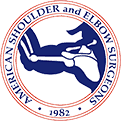Each year, the society issues call for proposals encouraging new investigators to apply for seed and start-up funding for promising shoulder and elbow research projects. Grants of up to $20,000, for work to be performed over 12-24 months, are considered. Only orthopaedic surgeons acting as principal investigators are eligible to apply. All applications are reviewed and graded by the ASES Research Committee.
Instructions and Guidelines as well as the 2024 Research Grant Application is posted below.
Instructions and Guidelines
Grant Application (Word)
Grant Application (PDF)
The submission deadline for 2024 grant applications will be in February 22nd, 2024.
Completed applications can be emailed to ASES at info@ases-assn.org.
Grants will be reviewed by the ASES Research Committee. Applicants will be notified by Mid-May 2024.
The period of the grant will be from July 1, 2024 through June 30, 2025.
The PDF version of the Grant Application requires Adobe® Acrobat® Reader to open.
Please click here to download and install the Adobe® Acrobat® Reader software on your computer free-of-charge.
Ivan Wong, MD
Latarjet vs anatomic glenoid reconstruction for the treatment of anterior shoulder instability with glenoid bone loss: a prospective multi-center randomized trial
Joseph King, MD
Prospective, Multicenter Study of Proximal Humerus Fracture Outcomes
Luke S. Oh, MD
The Importance of Collagen Telopeptides in Tendon Healing in a Rodent Rotator Cuff Model
Grant E. Garrigues, MD
Periprosthetic Tissue Response to Wear and Corrosion Debris from Total Shoulder Arthroplasties
Umasuthan (Uma) Srikumaran, MBA, MD, MPH
Opioid Prescription Practices After Orthopedic Shoulder Surgery: A Prospective Cohort Study
Aaron Nauth, MD, MSc, FRCSC
The Impact of Psychological Factors on the Outcome of Surgical Repair for Rotator Cuff Tears – A Prospective Cohort
Charles M. Jobin, MD
Intrawound Antibiotic Powder for Eradication of Surgical Wound Contamination during Shoulder Arthroplasty: An in Vivo Animal Study
Andrew F. Kuntz, MD
Effects of Aging on Tendon Cell Metabolism
David Kovacevic, MD
Amniotic Fluid-Derived Allograft to Improve Rotator Cuff Tendon-Bone Healing
Claudius Jarrett, MD
SDF-1 Release to Prevent Muscle Degeneration in Rotator Cuff Tears
Spencer P. Lake, BS, PhD
Etiology of Post-Traumatic Stiffness and Joint Contracture using and Animal Model
Eric T. Ricchetti, MD
Analysis of Synovia Fluid Interleukin-6 Levels and Cytokine Profiles in Diagnosis of Prosthetic Joint Infections of the Shoulders
Daryl C. Osbahr, MD
Impact of the Pattern and Size of an Ulnar Collateral Ligament Tear on Contact pressure and Area in the Posteromedial Compartment of the Elbow
Asheesh Bedi, MD
A Comparison between the Contractile & Morphological Properties of Rotator Cuff Muscles of Patients with Mild or Severe Fatty Atrophy
Theodore A. Blaine, MD
Chemokine Expression and Inhibition in Subacromial Bursitis and Rotator Cuff Disease
Daniel Whelan, MD, FRCS(C)
A Randomized Evaluation of Emergent Immobilization in External Rotation in the Management of Acute Anterior Dislocations of the Shoulder (EERAADS)
Deenesh T. Sahajpal, MD
Kinematics Assessment and Electromyographic Analysis of Patients with Reverse Total Shoulder Arthroplasty
J. Michael Wiater, MD
The Influence of Design Features on the Wear Performance of Reverse Total Shoulder Arthroplasty Systems: an In Vitro Wear Simulation
Leesa M. Galatz, MD
The Role of Stress Environment on Formation of Tendon-Bone Insertion
Young W. Kwon, MD, PhD
Biomechanical Analysis of Reverse Total Shoulder Glenoid Fixation
Peter B. MacDonald, MD, FRCS(C)
The Randomized Controlled Trial Comparing Pegged vs. Keeled Glenoid Components in Total Shoulder Replacements: The Use of RSA to Assess Micromotion
Theodore A. Blaine, MD
Cytokine Expression in Subacromial Bursitis and Rotator Cuff Disease
Orr Limpisvasti, MD
Ideal Glenohumeral Position for Reduction and Coaptation of a Bankart Lesion
Ronald A. Navarro, MD
Are Higher Shoulder Arthroplasty Case Volume and Surgeon Experience Level Associated with Better Patient Outcomes?
Michael D. McKee, MD
Randomized Evaluation of Immobilization in External Rotation for the Management of Acute Anterior Dislocations of the Shoulder (ERAADS)
Michael L. Pearl, MD
Arthroscopic Release of Internal Rotation Contractures from Brachial Plexus Birth Palsy: Follow-Up Study of Shoulder Function and Glenoid Development
Jon K. Sekiya, MD
Humeral Head Defects (Hill-Sachs Lesions) Associated with Anterior Shoulder Instability: The Effect of Defect Size, Measurement Parameters, and Percutaneous Correction (Humeroplasty) on Glenohumeral Translation
Kevin L. Smith, MD
Periosteal Arthroplasty of the Reamed Glenoid Surface: A Morphological and Histological Analysis in a Rabbit Model of Non-prosthetic Arhtroplasty
Mininder S. Kocher, MD, MPH
Reliability and Validity of the ASES Shoulder Score
Tim L. Uhl, PhD, ATC, PT
Evaluation of Scapular Dyskinesis
Hans K. Uhthoff, MD
Correlation Between the Increasing Tensile Strength of the Supraspinatus Tendon and teh Reformation of Fibrocartilage
Richard E. Debski, PhD
Biomechanical Analysis of AC Joint Function



